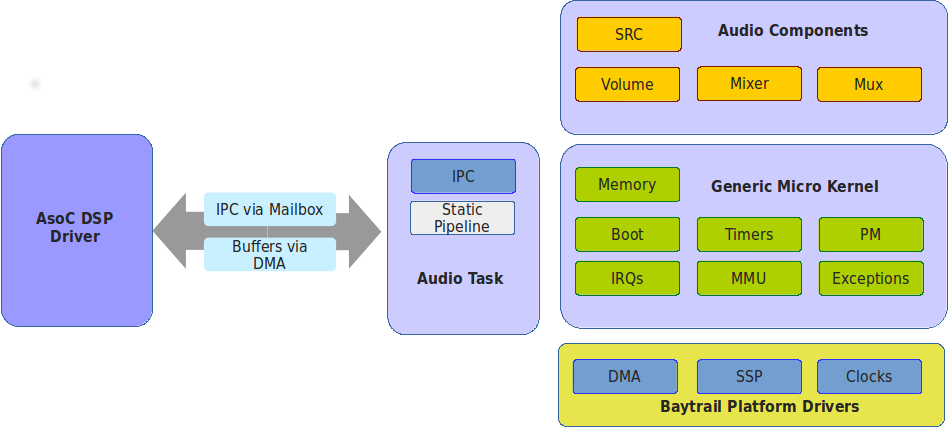DSP Architecture¶
Currently SOF has support for the Cadence Xtensa DSP architecture in UP and SMP modes in the upstream code base today.
The diagram below shows the high-level firmware architecture with the Baytrail platform integration as an example. The firmware is divided into four main sections:
Generic microkernel. The microkernel manages and abstracts the DSP hardware for the rest of the system. It also exports C APIs for memory allocation, scheduling work, event notifications, and power management.
Audio components. The audio components can be used to form an audio processing pipeline from the host DMA buffer to the DSP digital audio interface. Audio components will have a source and sink buffer where they will usually transform or route audio data as part of their processing.
Audio task. The audio task manages the audio pipelines at run time; it manages the transportation of data from source to sink component within the pipeline. The pipelines are currently statically defined in the firmware, but infrastructure is now in place to allow the dynamic creation of pipelines from Linux userspace.
Platform drivers. The platform drivers are used to control any external IP to the DSP IP. This will usually be things like DMA engines or DAI (Digital Audio Interface) controllers. These drivers are used by the audio components and pipelines to send/receive data to/from the host and external codecs.

Figure 4 Sound Open Firmware Architecture using Intel Baytrail Platform¶
Each section above is well insulated from the other sections by partitioning code into separate directories and by using DSP and platform agnostic generic APIs for orchestration between the sections.
Adding a new DSP architecture to SOF¶
This is not yet a guide for architecure porting, but in general are two ways to add support for new DSP architectures to SOF.
Write a new Hardware Abstraction Layer (HAL) for your DSP.
Use an existing RTOS that supports your DSP architecture as a HAL for SOF.
Both methods require a working compiler for the new DSP architecture and preferrably an emulation environment or hardware debugger to help with the bringup and debug.
Method 1 - New HAL¶
The main work in adding the new architecture HAL is duplicating and porting the src/arch directory to your new architecture. The code in the architecture directory mainly deals with architecture abstraction and initialization of any architecture IP like MMU, IRQs and caches alongside providing optimized versions of some common C functions (memcpy, memset, etc) for that architecture. Adding a new architecture also usually means adding a new host platform too.
Method 2 - Use existing RTOS¶
This method involves creating a HAL by wrapping the RTOS functions used by SOF as thinly as possible (i.e. to compile out). It also means removing unused code from the SOF build in order to use the RTOS version if desireable i.e. allocator, schedulers, messaging etc. The final stage is to link the SOF audio code to the RTOS.